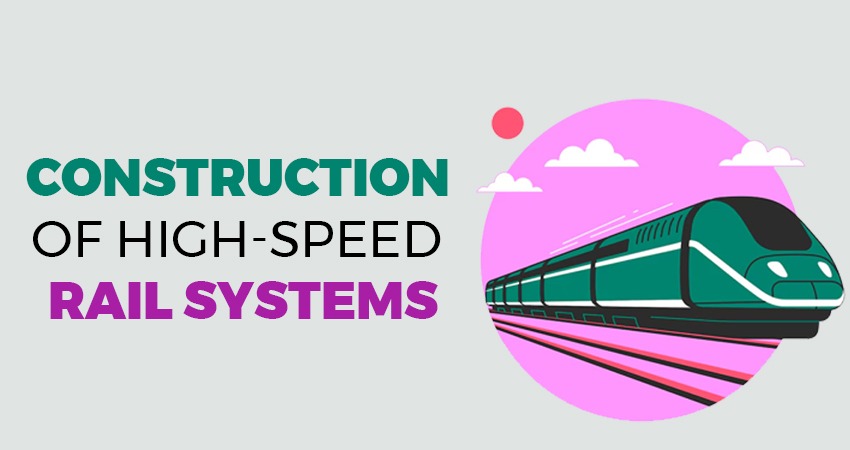The design and construction of high-speed rail systems from Engineers Heaven's Idea / Prospect

High speed rail is a leap innovation in
the Indian transportation map, which is set to glide across great distances at
great speed, effectively and environmentally friendly. Such systems are complex
and designing and constructing them must be done with a lot of detail.
Design Factors
The design of HSR systems involves the
following critical factors:
●
Route Selection:
The first route is the best route is the first consideration. It should link
the big cities with least impact on the environment and society. The alignment
is established by geological, ecological and demographic feasibility studies
that are conducted.
●
Track Design: HSR
specific tracks are not the same as conventional rail tracks. The tracks are
intended to sustain speeds over 300 km/h. Track geometry that refers to
alignment, elevation, and curvature of tracks aims at the necessary precision
that will guarantee comfort and safety of passengers.
Structural Engineering: Some of infrastructure includes bridges, tunnels,
and viaducts as part of the HSR. Such structures require the ability to bear
dynamic loads and other factors in the environment. The necessary strength and
protection are achieved with the help of modern materials and construction
approaches.
Aerodynamic Design:Higher speed rail transport experiences a lot of
drag force. The designs of the trains minimize drag and therefore promote
energy efficiency and stability of the train. Closeness to the road also
eliminates aerodynamic factors and reduces noise pollution hence making the
journey more enjoyable.
Challenges to construction:
Construction phase of HSR system poses
specific challenges:
Land Acquisition: Gaining land for the vast HSR network is usually
an issue of concern. It is a process of reconciling the developmental
objectives with the rights and interests of the people within the development
region. It can only be solved by proper communication transparency and
reasonable remunerations.
Technological Integration:The use of more technology in the system is of
paramount significance. This includes the signals, communication channels and
automations of the systems. In promoting both interoperation and reliability,
application of testing and quality assurance methods cannot be overemphasized.
Environmental Impact: Construction has impacts on ecosystems.
Environmental audits are employed so as to identify measures for minimizing
harm to the environment in as much as an effort is made to protect the
biological diversity and natural ecosystems.
Cost Management: HSR projects are capital-intensive. Budgeting and
financial planning must be sound to avoid cost overruns. Public-private
partnerships and alternative funding models can ease the fiscal pressure.
Case Study: Mumbai-Ahmedabad Corridor
The Mumbai-Ahmedabad corridor is the very
first HSR project launched in India. This measures about 508 kilometers with a
designed speed of about 320 km/h. The Japanese Shinkansen technology will be
adopted into the project, famous for its safety and efficiency in the market.
It calls for high use of viaducts and tunnels due to the variations in terrain.
Indigenous manufacture is another feature as they will start manufacturing some
of the parts locally, promoting more technological progress and job production.
Future Prospects
A gargantuan HSR network: India plans to develop
more than a few corridors like the following:
●
Delhi-Varanasi:
Connecting the capital to this spiritual
city will further contribute to tourism and economic activities.
●
Mumbai-Nagpur:
This is envisaged to strengthen internal
links within Maharashtra, leading towards regional development.
●
Delhi-Amritsar
Connecting the national capital to the
cultural hub of the state of Punjab is one of the proposed links aiming for
trade and travel.
They are at different stages in planning
and development.
The design and construction of high-speed
rail systems in India are monumental endeavors that require a harmonious blend
of advanced engineering, strategic planning, and sustainable practices. These
projects, when progressed, promise to revolutionize travel, stimulate economic
growth, and contribute to the nation's development.
Engineer’s Heaven is a vibrant platform
for engineers and enthusiasts who are eager to explore such transformative
projects. It is a community that brings ideas together to innovate and
collaborate in the engineering world.
(Disclaimer: This statistics could be different in different part of World and Different timeline. this statistics has been generated based on data available till 2024 or relavant time span.)
SOURCES:
https://en.wikipedia.org/wiki/High-speed_rail_in_India

The Wall